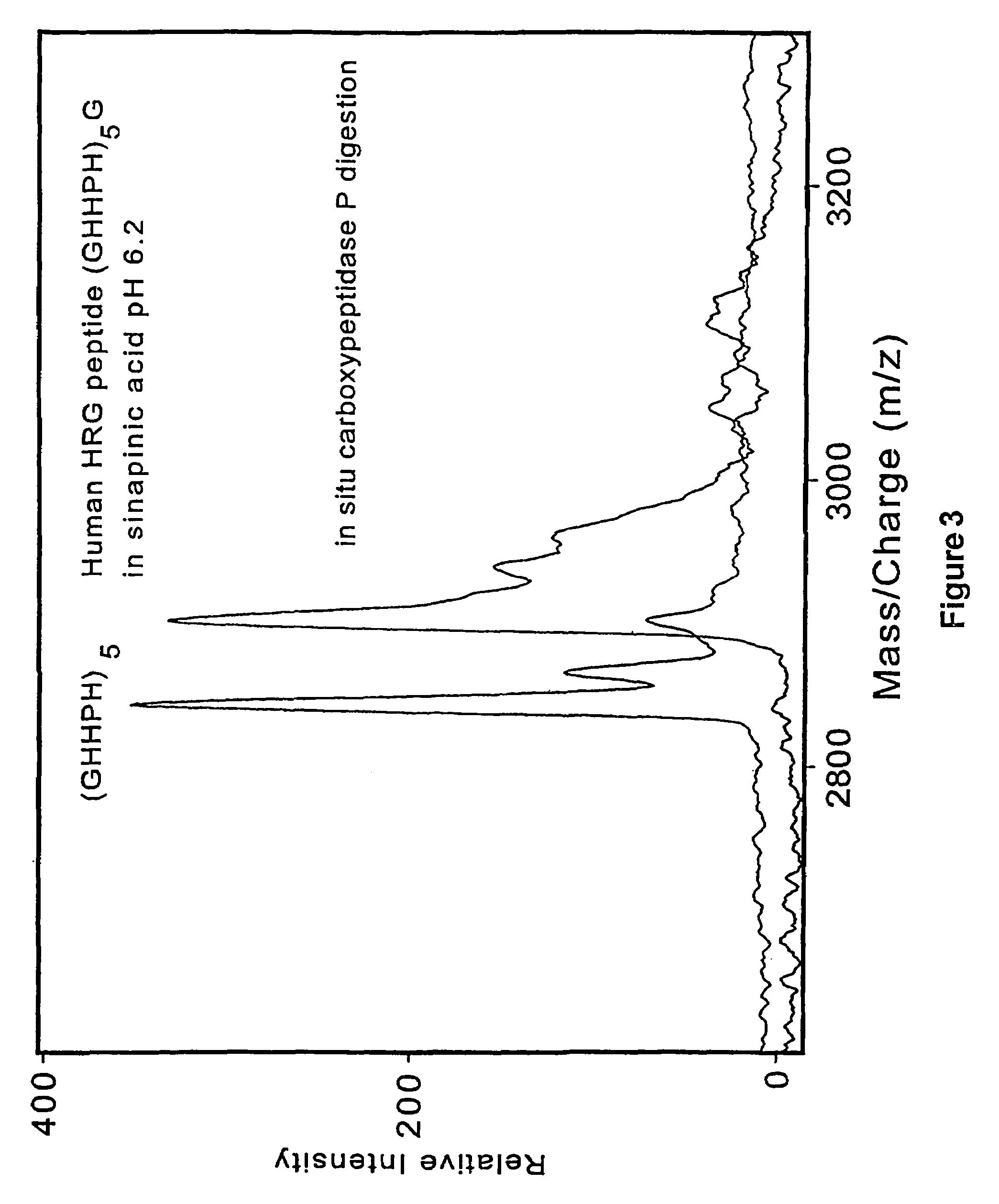Method and apparatus for desorption and ionization of analytes
a technology of analytes and ionization, applied in the field of methods and apparatus for desorption and ionization of analytes, can solve the problems of inability to determine the mass, identity, and difficulty of the original macromolecule, and the prior art procedure has several limitations, and can not be applied in the direction of particle separator tube details, instruments,
- Summary
- Abstract
- Description
- Claims
- Application Information
AI Technical Summary
Benefits of technology
Problems solved by technology
Method used
Image
Examples
example 1
Energy Absorbing Molecules in Aqueous, Neutralized Form
[0145]Prior art matrix material used in matrix-assisted laser desorption time-of-flight mass spectrometry are strongly acidic. One of the present discoveries is that analytes is desorbed when mixed with neutralized energy absorbing molecules dissolved in entirely aqueous solvents. By suitable neutralization to pH 6.0 or above, the matrix material is made largely passive to subsequent chemical or enzymatic reactions carried out on the analyte molecules presented on the probe tip surfaces. Since only a small fraction of the analyte molecules are used in each desorption / mass spectrometer measurement, the samples on the probe tips are available for in situ sequential chemical or enzymatic modifications. After modification the samples are analyzed by mass spectrometry. Analysis on the same probe tips provides a more accurate determination of the molecule and its characteristics, including its structure.
[0146]Mass spectrometry is perf...
example 2
Nonmetallic Probe Elements (Sample Presenting Surfaces)
[0151]It has been found that the probe elements (probe tips or sample presenting surfaces) used in the process of the invention need not be metal or metal-coated, as described in prior art procedures. The sample presenting surfaces are composed of a variety of materials, including porous or nonporous materials, with the porous materials providing sponge-like, polymeric, high surface areas for optimized adsorption and presentation of analyte.
[0152]Polypropylene or polystyrene or polyethylene or polycarbonate are melted in an open flame and deposited as a thin layer on a 2 mm diameter stainless steel probe element so as to cover it completely. Solid glass rod or solid nylon filaments (up to 1.5 mm diameter) or polyacrylamide rod are cut into 1 cm segments and inserted into the stainless steel probe support. Magnetic stir bars (1.5×8 mm, teflon-coated) are inserted into stainless steel probe tip support. An aliquot of 1 μl of pepti...
example 3
Affinity-directed Laser Desorption
(Surface Enhanced Affinity Capture, SEAC)
[0154]This example describes the use of existing and new solid phase affinity reagents designed for the (1) capture (adsorption) of one or more analytes, (2) the preparation of these captured analytes (e.g., washing with water or other buffered or nonbuffered solutions to remove contaminants such as salts, and multiple cycles of washing, such as with polar organic solvent, detergent-dissolving solvent, dilute acid, dilute base or urea), and (3) most importantly, the direct transfer of these captured and prepared analytes to the probe surface for subsequent analyte desorption (for detection, quantification and / or mass analysis). Affinity capture devices are immobilized on a variety of materials, including electrically insulating materials (porous and nonporous), flexible or nonrigid materials, optically transparent materials (e.g., glass, including glass of varying densities, thicknesses, colors and with varyi...
PUM
| Property | Measurement | Unit |
|---|---|---|
| molecular mass | aaaaa | aaaaa |
| molecular mass | aaaaa | aaaaa |
| molecular weights | aaaaa | aaaaa |
Abstract
Description
Claims
Application Information
 Login to View More
Login to View More - R&D
- Intellectual Property
- Life Sciences
- Materials
- Tech Scout
- Unparalleled Data Quality
- Higher Quality Content
- 60% Fewer Hallucinations
Browse by: Latest US Patents, China's latest patents, Technical Efficacy Thesaurus, Application Domain, Technology Topic, Popular Technical Reports.
© 2025 PatSnap. All rights reserved.Legal|Privacy policy|Modern Slavery Act Transparency Statement|Sitemap|About US| Contact US: help@patsnap.com



